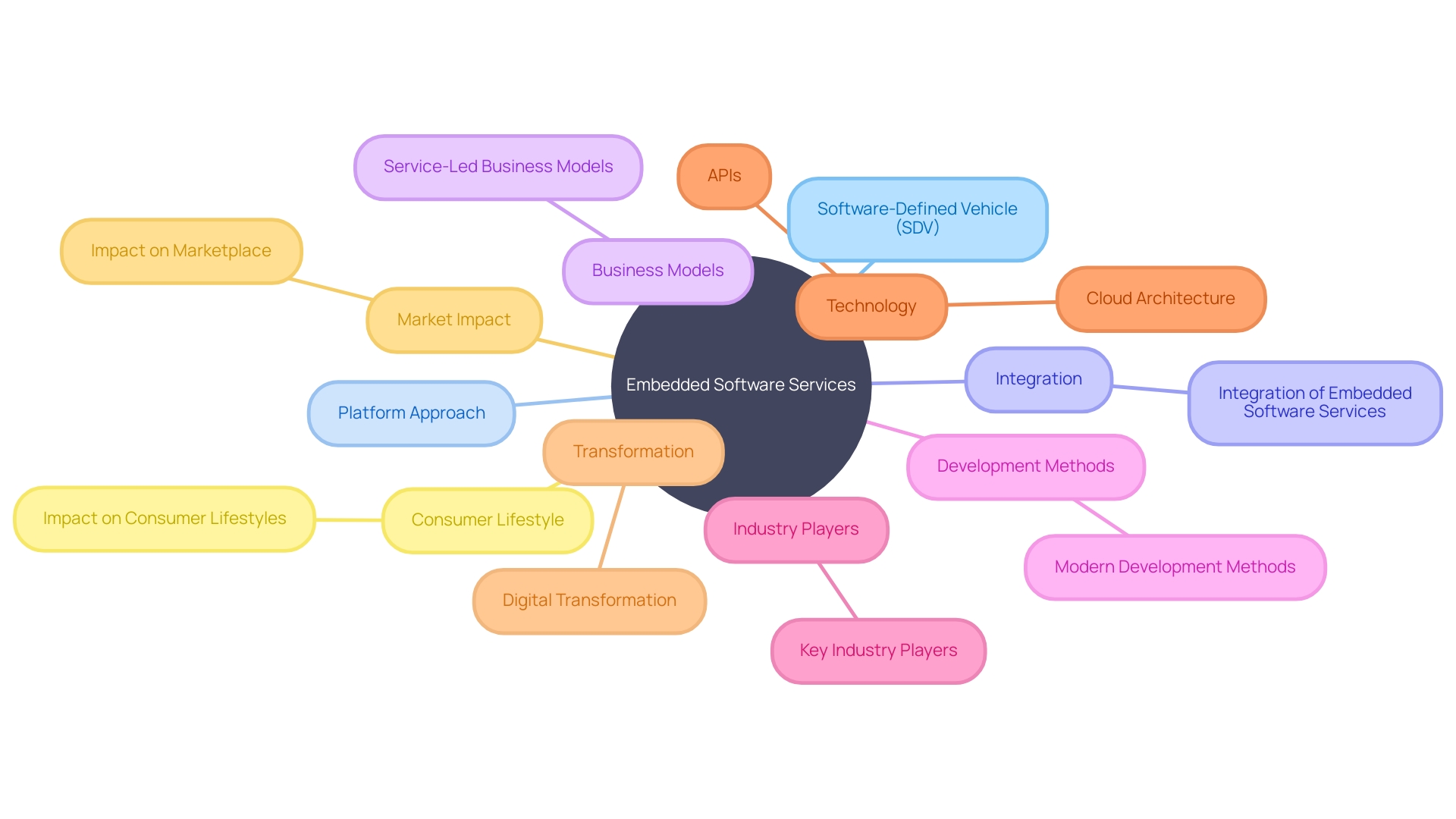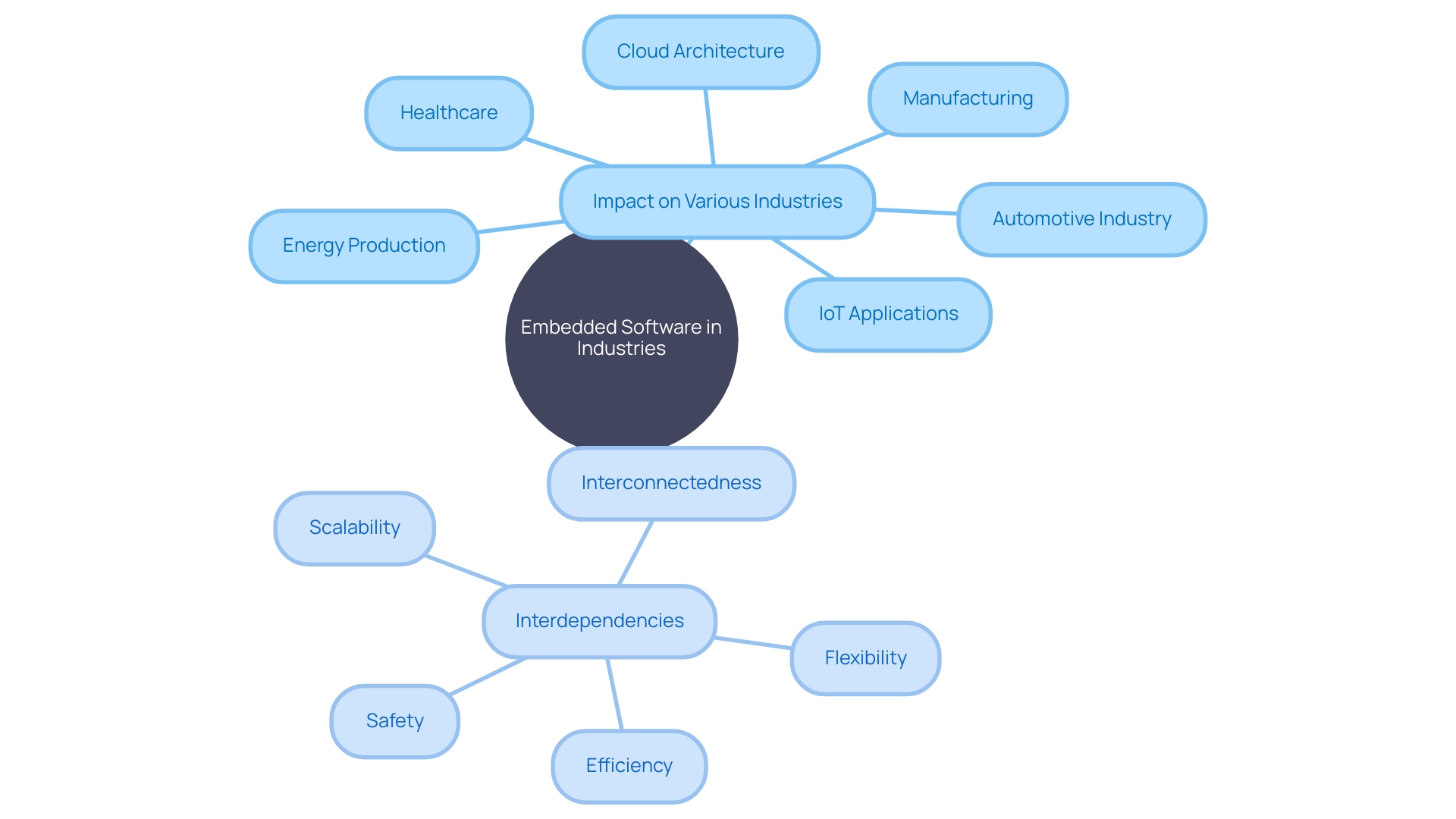Introduction
Embedded software services have become a driving force behind the transformation of industries, revolutionizing how companies operate and interact with technology. From the automotive sector to manufacturing and healthcare, embedded software companies are at the forefront of innovative solutions that enhance efficiency and flexibility. With the market projected to reach $21.2 billion by 2028, these services are invaluable tools for industries looking to adapt and lead in an ever-changing landscape.
In this article, we will explore the evolution of embedded software services, case studies showcasing industry transformation, the benefits these services bring, the challenges faced in implementing them, and future trends and innovations in the field. Join us as we delve into the world of embedded software and its impact on the future of various sectors.
The Evolution of Embedded Software Services
Embedded software companies are not only evolving with technology, but they're leading the charge in transforming how industries operate. For example, Vodafone revolutionized customer service by harnessing cloud architecture, reducing a 20-person job to just five individuals. Bosch's development of the solid oxide fuel cell (SOFC) system, supported by a digital twin, showcases how deeply embedded software impacts energy efficiency and green power.
Similarly, TotalEnergies Digital Factory (TDF) has utilized APIs to transform legacy systems, resulting in over 80 solutions deployed across 25 countries.
The profound effects of digital transformation also shine in manufacturing and healthcare, leveraging advancements in AI that streamline complex data management and analysis. ByteSnap Design's approach to extending the lifespan of medical devices is another testament to the cost-saving and innovative capabilities that embedded software provides, as they support a broad spectrum of operating systems.
Continuous Delivery (CD) exemplifies how embedded software shapes organizational mindsets and operations, by encouraging rapid, reliable, and incremental updates to applications. Ai's role as a strategic enabler reflects the shift from software as a support function to a core strategic asset. This shift is further evidenced in the auto industry's transition to software-defined vehicles (SDVs), blurring the lines between automotive and tech companies.
With a market poised to grow at a CAGR of 11% from 2023 until 2028, reaching $21.2 billion, embedded software services are invaluable tools, ensuring industries not only adapt to changes but lead them. By reducing the costs and obstacles to adoption, these embedded solutions empower companies to achieve more with fewer resources, reflecting a future where every company, regardless of sector, is becoming a tech company.
Case Study: Industry Transformation through Embedded Software
Embedded software companies are redefining how we interact with technology in our everyday lives, particularly within the automotive sector, where the advent of the software-defined vehicle (SDV) has marked a turning point. These vehicles, unlike their predecessors, are no longer static but evolve over time, gaining new capabilities long after they've left the showroom floor. This is possible through a platform approach that guides software to run on a network of dedicated microcontrollers distributed around the vehicle, synchronizing complex subsystems.
Consider the case of an influential automotive manufacturer that embraced embedded software services to tackle the challenges of enhancing the performance and efficiency of their vehicles. The integration of these services allowed the company to introduce a fleet of cars equipped with state-of-the-art driver-assistance systems. This vital transformation not only uplifted the driving experience but also crowned the organization as an innovation leader in the automotive realm.
Such an approach aligns perfectly with the industry's swift pivot to service-led business models. It underscores the importance of a seamless harmony between hardware and software, facilitated by modern development methods that are in line with current modeling languages and standards, such as UML and AUTOSAR.
This shift is echoed by global technology powerhouses, like Siemens AG, which, through its extensive workforce and innovation across various industries, has reported significant revenue and net income. Similarly, Bosch's proficiency in vehicular domains gives it an unrivaled competitive edge, nurturing the growth of vehicle computers for infotainment and assistance systems, forecasting the market volume to significantly expand by 2030.
Cloud architecture and APIs play pivotal roles in this technological evolution, improving not only customer experience but also the workflow and efficiency of engineering teams. The merging of digital twins and the digital transformation led by companies like TotalEnergies and Vodafone exemplify the profound impact embedded software services impart on both the marketplace and consumer lifestyles.
From the automation revolution brought by generative AI to the vision of complex yet flawlessly integrated service systems, embedded software services have indeed become the cornerstone of dynamic, future-proof industries, encapsulating the essence of innovation that carries the potential to continuously upgrade and redefine user experiences and industry standards.

Benefits of Embedded Software Services
Embedded software is revolutionizing industries by enhancing flexibility, scalability, and efficiency. It custom-fits technological solutions to specific industry demands, allowing for seamless updates and adaptations. For instance, Bosch leveraged its digital expertise to create a solid oxide fuel cell system, reflecting embedded software's role in making energy production not only more efficient but also sustainable.
This system, which can be scaled to power large facilities, relies on a digital twin to monitor and optimize performance, illustrating the tangible impacts of embedded technology.
Moreover, embedded software services streamline operations to bolster productivity. Vodafone's cloud architecture serves as an example where a reduction in the required workforce for IT infrastructure maintenance during product launches demonstrates significant operational improvements. The software's role as the linchpin in IoT applications further underscores its value.
It facilitates smart device interaction, yielding actionable insights from data collection, akin to industrial sensors optimizing factory lines. The transformative power of integrated software, observed in industries evolving towards software-defined vehicles, speaks volumes about its potential to redefine productivity and competitiveness in the market.
This progress is largely driven by digital technologies that are central to manufacturing, healthcare, and asset management in various industries, where AI and cloud computing reduce investment barriers. This democratizes access to powerful data analytics tools, expediting the digital transformation. The automotive industry's ongoing metamorphosis into a field presided over by software-driven innovation stands as a testament to the profound impact of embedded software.
Safety systems in vehicles now boast active hardware and software technologies, such as sensor fusion, to prevent accidents, highlighting the sophisticated integration capabilities of embedded software companies.

Challenges and Solutions in Implementing Embedded Software
Embedded software companies confront the intricate challenge of integrating their services into existing hardware systems, a task that demands vigilant planning, conscientious testing, and seamless collaboration between software and hardware teams. The 24/7 operation of IoT devices, as opposed to periodic reboots in the past, underscores the criticality of software robustness. As exemplified by a homeowner's experience with automated light switches, even minor glitches can disrupt the convenience and efficiency promised by connected devices.
In healthcare, the stakes are even higher, requiring flawless coordination of diagnostic processes to prevent cross-contamination and ensure swift, reliable care. Precision and reliability are not just operational goals but foundational to gaining trust in critical sectors. This commitment to excellence was demonstrated by Everyplace Labs, whose automated testing kiosk addressed emergency department bottlenecks during the Covid-19 crisis.
With the IoT market anticipated to burgeon to $40 billion, cybersecurity emerges as a paramount concern. The value of data and device reliance is matched only by the potential cost of breaches, driving the need for stringent security measures. As connected devices proliferate and become entrenched in daily life, developers are urged to prioritize security to maintain data integrity and sustain consumer trust.
This understanding is shared by industry experts like Robin Duke-Woolley and Bill Ingle, who recognize the dual trend of increased connectivity and heightened cyber threats.
Through meticulous documentation and the cultivation of robust development practices, bolstered by historical insights into programming language trends, software engineers can construct systems that are not only integrated and secure but also stand the test of time. The predominance of Java, C, and C++ over the past quarter-century attests to the value of stability in the technological landscape, a principle that remains valid as the frontier of IoT expands.
Future Trends and Innovations in Embedded Software
Embedded software companies are increasingly vital players in the intricate symphony of modern technology. Historically starting from more rudimentary tasks, they are now at the cusp of a major leap thanks to IoT devices, that not only demand expertly crafted firmware but also a seamless interplay with interconnected systems. The proliferation of IoT is not simply about more devices but the precision and autonomy they bring to the table—features that are chiefly driven by continual advancements in AI and ML algorithms.
Synthesizing software with the hardware it animates requires a blend of creativity and technical proficiency. Take, for example, CodeConductor.ai, which merges AI with an exhaustive 'Batteries Included Approach.' This methodology is not just about cranking out code; it's a holistic ecosystem that facilitates creation, testing, deployment, and iteration in a fluid cycle, crucial for businesses aiming to ride the IoT wave and leverage AI's potential to tailor experiences to user behavior.
However, embedded software's horizon is not without its challenges. As we usher in higher connectivity, the imperative for reliably secure systems escalates. The emergence of comprehensive connectivity services, demonstrated by managed WI-Fi and edge computing, typifies this two-fold trajectory of opportunity and obstacle.
Enterprises must navigate these waters carefully, drawing on real-time anomaly detection and cybersecurity measures to protect both the integrity and responsiveness of their networks.
In terms of market demand, IoT's staggering growth trajectory is undergirded by various factors, including the miniaturization of sensors, affordable communication technologies, and the plummeting costs of hardware components. It's a realization that's echoed throughout the industry. Reports of dramatic increases in connected devices point to a paradigm shift towards greater data transparency, which inevitably raises the stakes for dependable device security.
Embedded software companies are fast becoming the architects of these complex digital ecosystems. As exemplified by companies like Azulle, the shift from single-product origins to being forerunners in technological innovation is monumental. These firms must provide incomparable service, state-of-the-art devices, and leverage the type of human-centric design philosophies that prioritize real-world application and utility across a spectrum of industries, such as healthcare, manufacturing, and transport.
As we navigate a world that's increasingly intertwined with our digital fabric, embedded software lies at the heart. Its future—bound with IoT, AI, and state-of-the-art security measures—is indeed bright and brimming with opportunities that will continue transforming how businesses and consumers interact with the physical and digital realms.
Conclusion
In conclusion, embedded software services have revolutionized industries by enhancing efficiency, scalability, and flexibility. Case studies like Vodafone and Bosch show the profound impact of embedded software on customer service and energy efficiency. These services optimize productivity and competitiveness in sectors transitioning to software-defined vehicles.
The benefits of embedded software services are significant. They enable customized solutions that seamlessly adapt to industry demands. Companies like Bosch leverage embedded software to create sustainable energy systems.
Vodafone's cloud architecture reduces costs and improves customer experience. These services also optimize productivity, evident in industries transitioning to software-defined vehicles.
Implementing embedded software presents challenges. Collaboration between software and hardware teams is necessary for seamless integration. Reliability is essential in critical sectors like healthcare.
Security measures are paramount to protect data integrity and sustain consumer trust.
Looking ahead, embedded software services have a promising future. IoT devices demand expertly crafted firmware and seamless integration with interconnected systems, driven by advancements in AI and ML algorithms. Reliable and secure systems are vital as connectivity increases, requiring cybersecurity measures.
The market for embedded software services is expanding rapidly, driven by factors like sensor miniaturization and affordable communication technologies. Embedded software companies provide innovative solutions across industries. As businesses and consumers navigate a digital world, embedded software will transform interactions with the physical and digital realms.
Experience the power of embedded software and revolutionize your industry today!





